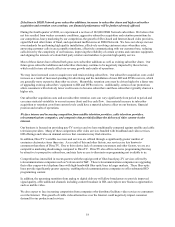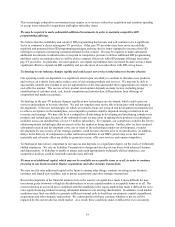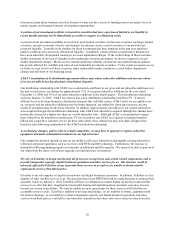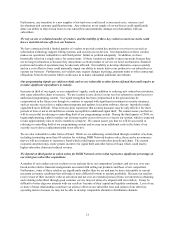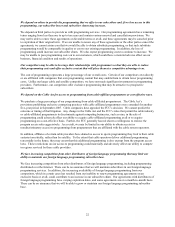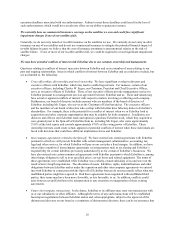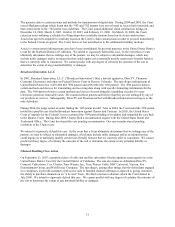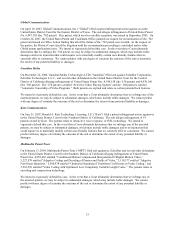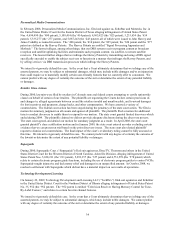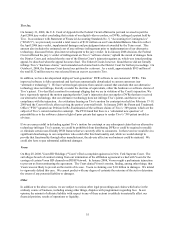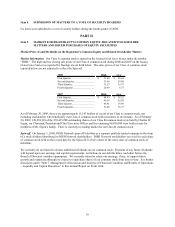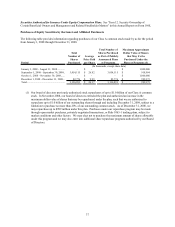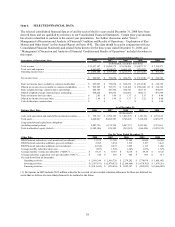Dish Network 2008 Annual Report Download - page 38
Download and view the complete annual report
Please find page 38 of the 2008 Dish Network annual report below. You can navigate through the pages in the report by either clicking on the pages listed below, or by using the keyword search tool below to find specific information within the annual report.
28
unable to obtain the intellectual property at any price, which could adversely affect our competitive position. Please
see further discussion under Item 1. Business — Patents and Trademarks of this Annual Report on Form 10-K.
We may pursue acquisitions and other strategic transactions to complement or expand our business which may
not be successful and in which we may lose the entire value of our investment.
Our future success may depend on opportunities to buy other businesses or technologies that could complement,
enhance or expand our current business or products or that might otherwise offer us growth opportunities. We may
not be able to complete such transactions and such transactions, if executed, pose significant risks and could have a
negative effect on our operations. Any transactions that we are able to identify and complete may involve a number
of risks, including:
x the diversion of our management’s attention from our existing business to integrate the operations and
personnel of the acquired or combined business or joint venture;
x possible adverse effects on our operating results during the integration process;
x a high degree of risk involved in these transactions, which could become substantial over time, and
higher exposure to significant financial losses if the underlying ventures are not successful; and
x our possible inability to achieve the intended objectives of the transaction.
In addition, we may not be able to successfully or profitably integrate, operate, maintain and manage our newly
acquired operations or employees. We may not be able to maintain uniform standards, controls, procedures and
policies, and this may lead to operational inefficiencies.
New acquisitions, joint ventures and other transactions may require the commitment of significant capital that would
otherwise be directed to investments in our existing businesses or be distributed to shareholders. Commitment of this
capital may cause us to defer or suspend any share repurchases that we otherwise may have made.
Our business depends substantially on FCC licenses that can expire or be revoked or modified and applications
that may not be granted.
If the FCC were to cancel, revoke, suspend or fail to renew any of our licenses or authorizations, it could have a
material adverse effect on our financial condition, profitability and cash flows. Specifically, loss of a frequency
authorization would reduce the amount of spectrum available to us, potentially reducing the amount of programming
and other services available to our subscribers. The materiality of such a loss of authorizations would vary based
upon, among other things, the location of the frequency used or the availability of replacement spectrum. In
addition, Congress often considers and enacts legislation that could affect us, and FCC proceedings to implement the
Communications Act and enforce its regulations are ongoing. We cannot predict the outcomes of these legislative
or regulatory proceedings or their effect on our business.
We are subject to digital HD “carry-one-carry-all” requirements that cause capacity constraints.
In order to provide any full-power analog local broadcast signal in any market today, we are required to retransmit
all qualifying analog broadcast signals in that market (“carry-one-carry-all”). The digital transition requires all full-
power broadcasters to cease transmission using analog signals and switch over to digital signals by June 12, 2009.
The switch to digital will provide broadcasters significantly greater capacity to provide high definition and multi-
cast programming. During March 2008, the FCC adopted new digital carriage rules that require DBS providers to
phase in carry-one-carry-all obligations with respect to the carriage of full-power broadcasters’ HD signals by
February 2013. The carriage of additional HD signals on our DBS system could cause us to experience significant
capacity constraints and limit the number of local markets that we can serve. The digital transition has also
necessitated resource-intensive efforts by us to transition broadcast signals switching from analog to digital at the
hundreds of local facilities we utilize across the nation to receive local channels and transmit them to our uplink
facilities.
In addition, the FCC is now considering whether to require DBS providers to carry broadcast stations in both
standard definition and high definition starting in 2010, in conjunction with the phased-in HD carry-one, carry-all
requirements adopted by the FCC. If we were required to carry multiple versions of each broadcast station, we


